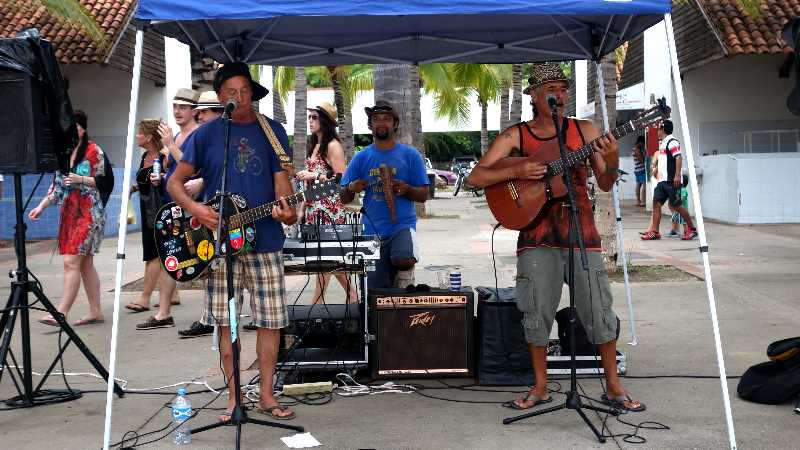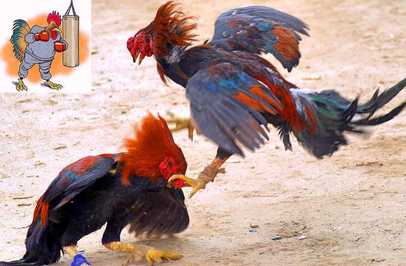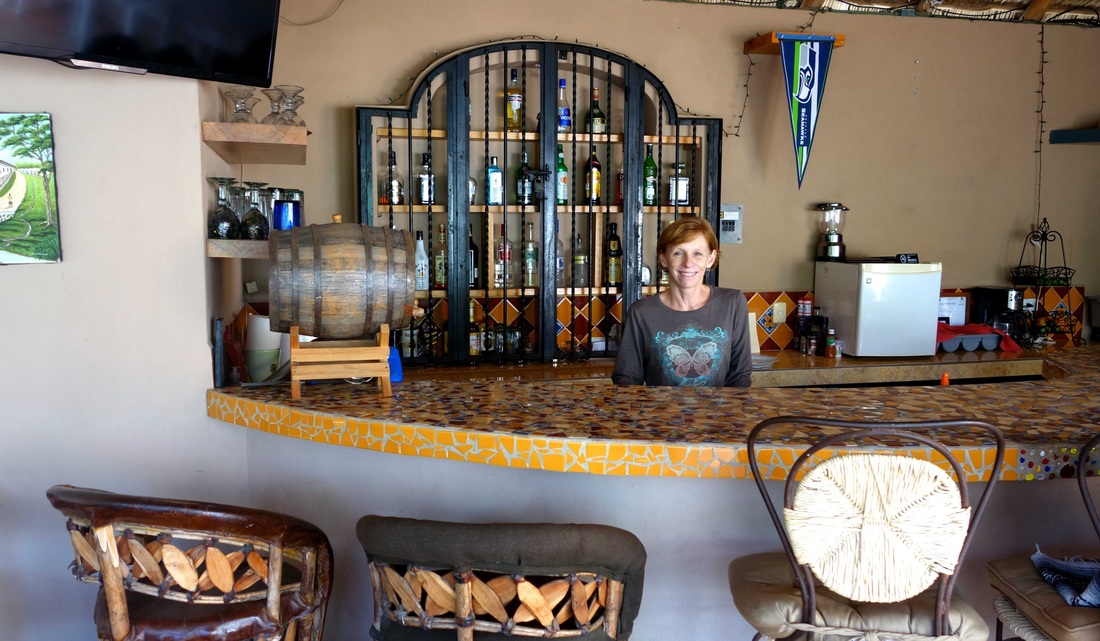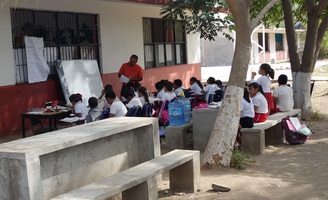It features food carts/stands, art, crafts, some vegetables, and other items. It is mostly for gringos but the quality of the goods is very good.. My favorite food item is the Italian sausage and chorizo with cole slaw sandwich (70 pesos). A band or two performs for the market people.
|
The Sunday Market in La Cruz de Huanacaxtle is one of the more popular markets in the Banderas Bay area and many even visit from other sections of Puerto Vallarta. It all happens from 10AM to 3PM on the Fish Market side of the marina in from of the Osos restaurant. It features food carts/stands, art, crafts, some vegetables, and other items. It is mostly for gringos but the quality of the goods is very good.. My favorite food item is the Italian sausage and chorizo with cole slaw sandwich (70 pesos). A band or two performs for the market people.
0 Comments
 Aruna Piroshki, proprietor, The Octopus' Garden Aruna Piroshki, proprietor, The Octopus' Garden The Jardin del Pulpo, as it is called in Spanish, is a unique compound in La Cruz de Huanacaxtle with several whimsical, connected structures. There is a yoga/dance studio upstairs which also hosts out-of-the-ordinary educational presentations and meditation sessions. A palaba bar is also located on the upper level. More recently, movies are being screened on some Mondays. There is a Huichol people arts and crafts gallery. A small cafe on the premises serves organic style fare cooked with love. The latest evolution of the Octopus will also entail a hostel operation which is currently under construction. The central area is replete with shade trees, murals on the walls, a fountain, wooden chairs and tables, an espresso machine, and a mutt that adopted the place. Slivers of sunshine filter through the grounds projecting an air of tranquility. Huichol Indian art gallery, you ask? The proprietors became intrigued by Huichol traditions and traveled to the Sierra Madre mountains to sell the Indians' crafts in their La Cruz gallery, including religious and ceremonial objects, crafted in weaving, embroidery, pottery and carving. Huichol art is noted for their vividly colored and patterned yarn work and beaded pieces. The brainchilds of this magical kingdom business are Egyptian-born Aruna Piroshki and Wayland Combe-Wright who met while studying architecture in London in the 1070s As I said in an earlier post, there are some interesting and eclectic souls in La Cruz. Aruna and Wayland fit the bill. Here is the short version of their unconventional tale which took them from architecture to performance and artistic endeavors. For the long version, you will have to wait for the book which reportedly is being written by Wayland. Their out-of-the-box life adventure began by selling samosas (deep-fried vegetable curry pastries) on a self-built fanciful bicycle food cart in London to save money to buy their first paint show horse which they named Taco. After buying another show horse, these self-taught performance artists began performing tricks with the horses and gave wagon rides at fairs and in the parks of London. The mini-circus life kept them busy, but their sights were set to travel to distant shores. Since it was difficult to purchase additional paint show horses in England, the pair contemplated traveling to the United States where these show horses were more plentiful. After evaluating all their low-cost options to get to America, such as airline travel and crewing on a sailboat, they opted instead to build a sailboat and sail it to the new world, with the added bonus of providing the stowage space to transport Wayland's woodworking tools. Undaunted by the fact that they never built a boat before, the project was commenced -- not with a set of boat building blueprints -- but but rather relied on their own resourceful ideas designed to keep the building costs within their budget. Wayland's woodworking skills helped boost the feasibility of the venture. After 2.5 years of working with local recycled materials to keep costs down, the unique 32-foot catamaran was finally completed. It was a labor of love using wood from their soon-to-be-demolished home, canvas, and tar/paper over a pine-and-ash wood frame. With with the help of about 40 volunteers, the craft, named Tavlua, was hauled manually to the launching point in the Cotswolds. Who needs boatyard travel lifts? Tavlua is a Polynesian expression loosely meaning "two stars" used in celestial navigation. This unique vessel was described by the owners as a cross between and Irish curragh and a Polynesian catamaran. Well, whatever it was, it took them to faraway places. After selling all their possessions in London, Aruna, Wayland, and their recently born daughter, set sail towards Central America with stops in the Canary Islands and the Barbados, where the journey stalled to do boat repairs to add to the cruising kitty. Two more years of cruising took them through the Panama Canal, Costa Rica, Nicaragua, and eventually Southern Mexico. During their short stay there, the family traveled to Guatemala and spent time with the Indians learning the indigenous art of weaving ... eventually fabricating and selling spinning wheels. The spinning wheels also helped cement relationships with Huichol craftsmen. The couple brought the artists down from the mountain to Puerto Vallarta to teacn them how to operate the more modern spinning machines with which to craft their artwork. Huichol traditional methods employed manual spinning techniques. If the Huichol artist in-training was able to master the spinning wheel, he received one for free to take back to the village. Aruna and Wayland helped finance this effort by selling silk screened T-shirts using the Huichols' artwork patterns. If you are wondering why the place was named The Octopus' Garden, then you need to know that the silk screening machines used to print the T-shirts were referred to as an 'octopus' in the silk screening industry due to their shape. After initially renting the compound grounds for five years, the couple finally purchased the Jardin in 1999 and continued to make upgrades to the complex as the business evolved. Unexpected disaster struck in May 2014. While doing repair work on the Jardin's roof structure, Wayland fell off a tall ladder. The accident resulted in critical spine damage but he endures and is in a long recovery process. The rehab prospects are slow but positive. Following a temporary closure of the Octopus due to the accident, the Jardin del Pulpo is morphing into its next phase. After selling the silk screening machines to locals, Aruna is busy converting the space formerly occupied by the machines to a hostel with accommodations ranging from several private rooms, studios, and two dorm rooms. Visitors to La Cruz will be able to stay there after construction is completed starting at about 180 pesos a night in the dorm rooms. The Huichol gallery, cafe and upstairs studio will continue to be part of the operation. The Pulpo may not exactly be La Cruz' answer to Esalen, but it will be attractive to budget-minded single travelers with the added bonus of community areas, a cafe, an espresso bar and the opportunity to participate in various new age activities and workshops. What became of Tavlua which transported the couple on their unlikely journey ending in La Cruz? The vessel was taken apart and the wood was used in the construction of the original building. It became the soul of the Octopus. I was house-bound for several days due the heavy rain squalls around Bandera Bay. Some of the streets get quite muddy and even become small rivers in la Cruz during rainstorms. But it dries up in a day or so. Locals said it was unusual to have such rainstorms at this time of the year. This morning the sun shines again with clouds covering the Vallejo mountains.
On Sunday I did sneak out between rain squalls to go to the market to sample the locally-made Italian and chorizo sausages. I had a combo Italian sausage and chorizo sandwich…muy delicioso. Also I did a video of a local band playing at the market called “La Payasos del Mer” (The Sea Clowns) playing a Mexican tune called something like “The Pretty Black Girl Drives Me Crazy.” For its smallish size, La Cruz has a very vibrant music scene with musical venues at the restaurants most days of the week. The market is quite an attraction here which happens on Sundays near the channel entrance to the marina, just a few blocks away from my abode. There are about 150 booth vendors at the market. It is well attended by mostly gringos and a few Mexicans. The vendors are mostly Mexican with a sprinkling of some gringos who live in the area. I will do a separate write-up on the Sunday market later. Don't expect the best prices but the quality is mostly very good. Later in the morning, I met with Chris Bouchard, the real estate man who I met earlier at an open house in Bucerias, for a coffee at the Osos restaurant. He is a Canadian who lived in the Vancouver area and operated a construction-related business servicing large hotels. He sold the business and embarked on a mid-life sabbatical. Eventually, he and his wife, Cindy, set off to La Cruz where they purchased a condo and later a large house by the beach near the marina entrance channel. The house was extensively refurbished and turned into a boutique hotel/B&B with five suites -- the Villa Amore del Mar. They also rent an adjoining casita. You can view their Villa of Love by the Sea at http://www.villaamordelmar.com. They return each year to a cabin by Drayton Bay by Semiahmoo for the summers (near Blaine, Washington). Cindy, an interior designer, operates the inn, and Chris started Domus Vallarta real estate a year ago, http://domusvallarta.com/en/. I will look at some properties with him during my stay in La Cruz. On the way home, I stopped by a typical Mexican eatery called “La Placita” (The Little Place) around the town square and had huevos rancheros. I noticed that restaurants in La Cruz are frequented by either only Mexicans or only gringos. There is a bit of intermingling sometimes, but not much. It looks like the locals and the gringos get along well. The gringos are doing a lot of charitable activities in La Cruz to help the local Mexican community. I sense a very good vibe here.  Yesterday, I had occasion to visit the city Valle de Banderas which was having its annual festival. It is about 20 miles inland from Bucerias and it took two combi buses (min-van) from La Cruz to get there. My guide, Alicia, has her roots in the El Valle area but now lives in Bucerias. With a population of about 7,000 it is the administrative seat of the surrounding municipality of Bahía de Banderas. The city is more commonly called 'El Valle' by the locals. I can say with certainty, that I was the one and only gringo in El Valle that night. In Mexico almost every pueblo has an annual fiesta which typically lasts about a week. They are closely connected with the Catholic church and usually are centered around the town plaza where the churches are located. There is always a mass in the church, eating, drinking, carnival rides, folkloric dancing, as well as mariachi bands. Debbie, Suz, Doug and I went to Bucerias' fiesta two weeks ago which also entailed the Blessing of the Fishing Boat fleet. El Valle is located at the foot of the Vallejo Mountains. In the pre-Columbian period, it was called "Tintoque" meaning "Valley of the Warriors." It was the village center of a small chieftainship of Cuyuteco Indians within the larger Xalisco homeland of the Cuyuteco. They cultivated the fertile fields of the valley, rather than going to the sea to fish, for their main food staples. Historical crops are still being farmed in the valley, including tobacco, corn, beans and chiles. Also now, an abundance of mangoes, chirimoyos, capomos, and date palms grow in the area. In 1525, the village was renamed "Valle de Banderas" (Valley of the Flags) by Francisco Cortés de Buenaventura, the nephew of Hernán Cortés, after he conquered the Pacific coast region. Upon arrival in El Valle, the mass was being celebrated in the 140 year old church. There were many street food stands and I had a beef tostada with a cerveza. Following the mass, there was energetic folkloric dancing and mariachis with lots of colorful dresses and costumes. After walking around a bit, we sat down to watch the show. On the way back to the bus in El Valle, I witnessed my first authentic gallo fight. Thanks to the Spanish colonizers who brought cock fighting to Mexico from the Philippines, it has become a cherished tradition in Mexico. The event I saw was being held in a large room with stadium type of seating around a 50-foot circumference sandy pit, the palenque. There seemed to be about 150 in attendance that night, both men and boys, who made bets on their favorite birds. Cock fighting seems to be a male-only spectator sport. The entrance fee was 50 pesos (about $3.50). It is the Mexican version of the circus games of the ancient Romans. The palenque is like a miniature Colosseum, and the gamecocks are like tiny gladiators; whenever two of them fight, only one is meant to survive. Tiny blades, which are first washed with lime juice to prevent cheating by poisoning the blades, were attached to legs of the roosters to make the fight quick and deadly. The roosters were introduced by their handlers and excited birds went at each as soon as they were released. The cocks flew forward, squawking, attacking each other with legs and beaks and wings flapping furiously, their feathers flying in a brief and brutal ballet. The scuffle was almost cartoonish in its speed and intensity. The birds moved so quickly, it’s like they were fighting in fast-forward. In a minute or so, it was over. One of the roosters was muerto ... lying in a pool of its own blood. The trainers, called galleros, usually work with a dozen birds from birth choosing the ones which have good fighting potential. They usually work for wealthy ranchers who own the roosters and bet on them during fights. The trainers must like their work with a passion because they only make about $1,000 pesos a month ($70). While training, the galleros make the roosters run on small treadmills and throw the birds in the air to make them flap their wings as this makes them stronger. The trainers feed them just right. In the end, the galleros never know which bird will win in the ring as it is often due to chance. Many roosters only fight once. The only consolation in the fighting rooster's typical two-year life is that while alive, they are treated like princes. I found a place to watch the Super Bowl this weekend in La Cruz,. It is called Charlie's Place on Calle Cameron. The palapa bar/restaurant has three 32-inch flat screen TVs. Their food specialty is wood fired brick stone oven pizzas. Various music venues are featured several times a week. There will be well over 100 people there so I'll have to go early to claim my seat. Go Seahawks!
The place was opened four years ago by a Seattle native, Charlie Wilker. He also worked at the French Laundry in Napa and the Lark Restaurant in Seattle. Charlie's was formerly known as the La Pajarita and Mango's Grill under different owners. Charlie's mother, Melinda, helps run the place. I also found out that there is no bakery in town of any culinary significance but I ran into this Mike person who is a baker and supplies various eateries with New York cheesecake, apple pie, and other sweets. He said he makes everything in his home kitchen … no need to use commercial kitchens here. Tonight, the ‘taco man’ went to Tacos on the Street restaurant at the corner of Calle Coral and Huachinango. It is interesting to note that all the street names in town are named after sea life. All the tables on the street were taken so I had to eat inside, a bit steamy and muggy compared to the calle seating All they serve here are corn or flour rib eye tacos with extras (see pic). And they only serve flan for dessert which I had to try. All were tasty. Good thing I had a cerveza to put out the fire from the roasted chillies served on the 'extras’ plate which comes with the taco. In case you are wondering, the town’s name comes from a cross (La Cruz) that is made of Huanacaxtle wood. The giant cross is located at the town's entrance. The wood is very sturdy and long lasting akin to teak. The area had an abundance of the wood 40 years ago, but no more. Most of the wood doors and furnishings in the house where I am staying are made from this wood. About 1,600 residents live here comprising of local Mexicans, Canadians, Americans, a few Europeans, and an interesting assortment of eclectic characters. While walking about the village, I meandered by the Emiliano Zapata elementary school. The entire school compound, including the soccer field, was walled off with a chain link fence. The classes were held outside and all the kids were neatly dressed, all wearing uniforms. It seems kids are better behaved and more respectful in Mexico. More on the town later. I arrived at the dusty side street, Calle Albatros at the casa which was to be my studio pad for a month. It is a villa with three studio units for rent. The unit was reasonably clean, basic kitchen appliances, cleaning products, broom/pan/toilet brush, soft bed with fitted sheets/mattress pad, AC, fans, 32-inch flat screen TV, a crystal clear swimming pool, and two terrier mutts named Tyson and Mohammed. Alas, the Internet does not work in the studio since it is too far from the wireless router. Marielza (Mari), the proprietor, said she will order an amplifier to boost the signal. Meanwhile, I work in the outdoor covered patio of the main house which has great view of ocean and the boat entrance channel which leads to the La Cruz marina … a ringside seat for watching boats arriving at and leaving from the marina.
Last night I walked around the dusty cobblestone streets of La Cruz and found a great outdoor taco joint called the La Ballena Blanca (The White Whale). Two fish tacos and a Pacifico for $5.00 … muy delicioso. Will definitely eat there again as I have become a “taco man." Also passed by Ana Banana’s, a place for breakfasts, burgers, desserts and such where a kids’ birthday party was in full swing ... kids singing and piñata breaking. I did a short video clip of that. Later at night, I found my way home with a bit of difficulty as I forgot to bring my flashlight and the side streets have no lighting after dark. I only stepped into one pothole on the way home without breaking my neck. I tried to do some Internet work on the patio but the long-legged mosquitoes that prowl here for human blood after dark chased me inside. |
Sailing Life
The Sailing Life blog will cover all aspects of sailing including voyages, maintenance, education, safety, destinations, lifestyle and others. Categories
All
Archives
July 2017
Blogroll
|












 RSS Feed
RSS Feed
